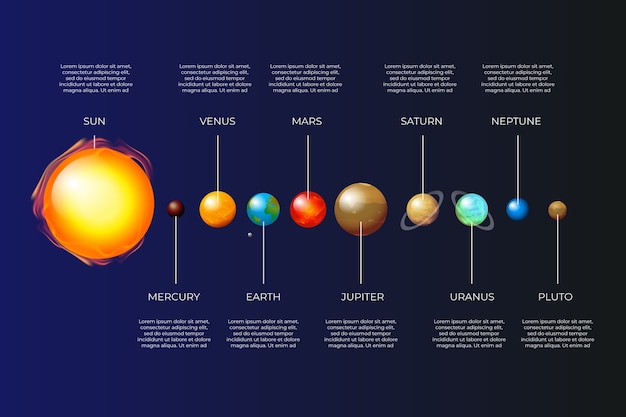

The solar system consists of eight planets, with the sun at its center.
The sun is so large that approximately 1.3 million Earths could fit inside it.
Jupiter, the largest planet in our solar system, could fit more than 1,300 Earths within it.
The solar system formed approximately 4.6 billion years ago.
The sun makes up about 99.86% of the total mass of the solar system.
The sun is classified as a G-type main-sequence star.
Earth is the third planet from the sun and the only one known to support life.
Saturn, the sixth planet from the sun, is famous for its beautiful and extensive ring system.
The sun’s gravity holds the solar system together.
Mercury is the closest planet to the sun and experiences extreme temperature variations.
Venus has a thick atmosphere that traps heat, making it the hottest planet in the solar system.
Mars, also known as the red planet, has surface features similar to both Earth and the moon.
Neptune is the farthest planet from the sun and takes about 165 Earth years to complete one orbit.
Uranus rotates on its side, giving it unique seasonal variations.
The asteroid belt, located between Mars and Jupiter, is a region with numerous asteroids.
The largest asteroid in the asteroid belt is Ceres, which is approximately 590 miles in diameter.
The Kuiper belt, beyond Neptune, is home to many icy bodies, including Pluto.
Pluto was reclassified as a dwarf planet in 2006.
The Hubble Space Telescope has provided significant knowledge about the solar system and beyond.
The solar system is located in the Milky Way galaxy, which is home to billions of stars.
The sun is expected to exist for approximately another 5 billion years.
Jupiter’s Great Red Spot is a persistent storm that has been monitored since the 17th century.
Io, one of Jupiter’s moons, is the most volcanically active body in the solar system.
The solar system’s largest volcano, Olympus Mons, is located on Mars.
Saturn’s moon Titan is the only moon known to have a thick atmosphere.
The solar system is in constant motion, with Earth rotating on its axis and orbiting the sun.
The sun’s energy is the primary source for supporting life on Earth through photosynthesis.
The solar system contains comets, which are icy bodies that orbit the sun.
Halley’s Comet, visible from Earth approximately every 76 years, is one of the most famous comets.
The solar system is incredibly vast, with the distance from the sun to Pluto being around 3.67 billion miles.
The solar system is part of the larger universe, which is constantly expanding.
The solar system’s formation began with a rotating disk of gas and dust called the solar nebula.
The Voyager 1 spacecraft, launched in 1977, has left the solar system and is now exploring interstellar space.
Ganymede, one of Jupiter’s moons, is the largest moon in the solar system.
The sun’s magnetic field extends far beyond the orbit of Pluto.
Earth’s moon is the fifth-largest moon in the solar system.
Mercury, named after the Roman god of commerce, is the fastest planet in the solar system.
Venus’ atmosphere is primarily composed of carbon dioxide, making it unsuitable for life as we know it.
Mars has the largest volcano, the deepest canyon, and the highest-known mountain in the solar system.
The solar system’s largest dwarf planet, Eris, was discovered in 2005.
The solar system contains numerous space debris, including spent rocket stages and defunct satellites.
The sun’s energy output is not constant and varies in a cycle that lasts approximately 11 years.
The solar system is constantly bombarded by cosmic rays, high-energy particles from outer space.
Io’s volcanic activity is a result of tidal heating caused by Jupiter’s immense gravitational pull.
Exploring the solar system provides valuable insights into the origins and future of our own planet.
Around the world, coffee enthusiasts enjoy Monin coffee concentrate since it is a multipurpose product. Conveniently combining…
The Importance of Choosing the Right Shower for Your Bathroom Renovating your bathroom can be…
Usain Bolt holds the record for the fastest 100-meter sprint in history.Bolt was named Sportsman…
Love is in the air... and it smells suspiciously like chocolate!Roses are red, violets are…
Life's a beach, take a picture and relax.Sun, sand, and salty kisses. That's what beach…
Hungary is home to the largest thermal water cave system in the world.The Rubik's Cube…